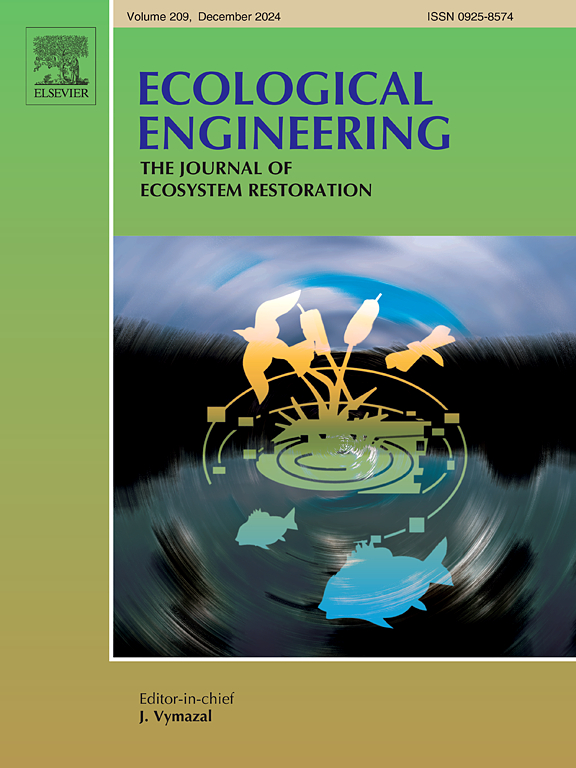Response of degraded Populus euphratica architectural variables to ecological engineering project in the lower Tarim River – A meta-analysis
IF 4.1
2区 环境科学与生态学
Q1 ECOLOGY
引用次数: 0
Abstract
Since its implementation in 2000, the ecological water diversion project (EWDP) has played a pivotal role in rehabilitating degraded desert riparian woodlands in the Tarim River Basin. While an extensive body of peer-reviewed research has objectively quantified the EWDP impacts on Populus euphratica forest regeneration, the predominant reliance on limited tree architectural variables employed in previous studies has constrained deeper understanding of riparian forest-EWDP interactions. This study synthesizes 635 observational datasets extracted from 21 rigorously screened publications searched in Web of Science Core Collection and China Knowledge Network Literature Database (CNKI) through a meta-analytical framework to systematically evaluate EWDP-ecological responses of P. euphratica under varying water management regimes. Our results demonstrate that EWDP significantly enhanced degraded forest recovery metrics, with mean increases of 60.28 % (crown diameter), 6.73 % (radial growth), 8.1 % (branch growth), and 12.81 % (growth ring index), respectively. Multivariate analysis identified dual-channel water diversion as the optimal delivery method, with peak efficacy achieved at annual water allocations of 3 × 108 to 6 × 108 m3 during the P. euphratica growing season (minimum 120 days duration). Notably, a 1–2-year lag effect was observed between water delivery initiation and measurable recovery responses. These findings establish an operational threshold for ecological flow releases and highlight the critical need for phenology-driven water scheduling aligned with P. euphratica species' hydraulic requirements. The proposed adaptive water management framework provides critical insights for optimizing water allocation strategies and ecological rehabilitation in arid regions under increasing hydrological uncertainty.

塔里木河下游退化胡杨林建筑变量对生态工程的响应——meta分析
自2000年实施以来,生态调水工程在塔里木河流域荒漠河岸林地的恢复中发挥了关键作用。虽然大量的同行评议研究客观地量化了EWDP对胡杨林更新的影响,但以往研究主要依赖有限的树木结构变量,限制了对河岸森林-EWDP相互作用的深入理解。本研究综合了Web of Science核心馆藏和中国知识网络文献数据库(CNKI)中21篇经过严格筛选的出版物中的635个观测数据集,通过元分析框架系统评价了不同水资源管理制度下胡杨的ewdp -生态响应。结果表明,EWDP显著提高了退化森林的恢复指标,平均提高了60.28%(冠径)、6.73%(径向生长)、8.1%(枝长)和12.81%(年轮指数)。多因素分析表明,双通道调水是最佳的调水方式,在胡杨生长季节(持续时间最少120 d),年配水量为3 × 108 ~ 6 × 108 m3时,调水效果达到峰值。值得注意的是,在输水开始和可测量的恢复响应之间观察到1 - 2年的滞后效应。这些发现建立了生态流量释放的操作阈值,并强调了与胡杨物种水力需求相一致的物候驱动的水量调度的迫切需要。提出的适应性水管理框架为在水文不确定性日益增加的干旱区优化水资源分配策略和生态恢复提供了重要见解。
本文章由计算机程序翻译,如有差异,请以英文原文为准。
求助全文
约1分钟内获得全文
求助全文
来源期刊

Ecological Engineering
环境科学-工程:环境
CiteScore
8.00
自引率
5.30%
发文量
293
审稿时长
57 days
期刊介绍:
Ecological engineering has been defined as the design of ecosystems for the mutual benefit of humans and nature. The journal is meant for ecologists who, because of their research interests or occupation, are involved in designing, monitoring, or restoring ecosystems, and can serve as a bridge between ecologists and engineers.
Specific topics covered in the journal include: habitat reconstruction; ecotechnology; synthetic ecology; bioengineering; restoration ecology; ecology conservation; ecosystem rehabilitation; stream and river restoration; reclamation ecology; non-renewable resource conservation. Descriptions of specific applications of ecological engineering are acceptable only when situated within context of adding novelty to current research and emphasizing ecosystem restoration. We do not accept purely descriptive reports on ecosystem structures (such as vegetation surveys), purely physical assessment of materials that can be used for ecological restoration, small-model studies carried out in the laboratory or greenhouse with artificial (waste)water or crop studies, or case studies on conventional wastewater treatment and eutrophication that do not offer an ecosystem restoration approach within the paper.
 求助内容:
求助内容: 应助结果提醒方式:
应助结果提醒方式:


